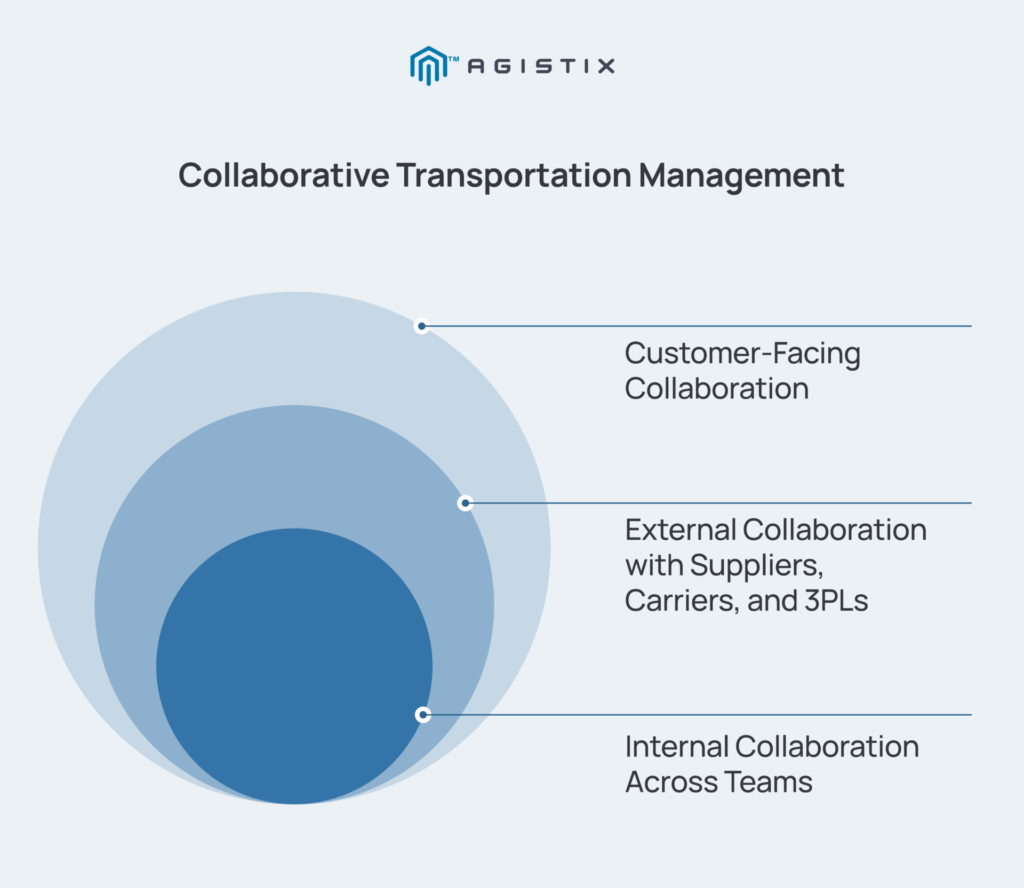August 15, 2025 - 5 minutes read

The Future of Transportation Management Software Is Collaborative
The logistics tech stack has come a long way, but too many transportation management software platforms still operate in isolation. They can book shipments, manage tenders, and automate routine tasks – but when it comes to connecting internal teams, suppliers, and customers, most fall short. The result isn’t just inefficiency. It’s a mix of miscommunication, avoidable delays, and a constant scramble to stay ahead of issues.
Collaboration is essential for managing global supply chains at scale. That means connecting fragmented systems and sharing real-time data across systems and stakeholders in a way that enables faster decisions and coordinated action.
This article explores why transportation management software needs to evolve to support true collaboration. It examines the consequences of disconnected systems and what it takes to align logistics execution with broader supply chain strategy.
Where Legacy Transportation Management Software Falls Short
Most transportation management software platforms are designed around a single function: shipment execution. They perform well when managing shipments booked directly through the system, but visibility often stops there. Inbound freight or shipments arranged by suppliers, 3PLs, or other internal teams is usually excluded, creating significant blind spots that logistics teams can’t afford.
Without access to shared, system-agnostic data, teams spend valuable time tracking down information instead of acting on it. Email threads, disconnected carrier portals, and manual updates introduce delays and confusion, especially when multiple parties are involved. The lack of a central, reliable source makes it difficult to verify status, resolve discrepancies, or change course in the face of disruptions.
These gaps introduce risk across both cost and service. When execution happens in one system and coordination in many others, there’s no reliable way to ensure accountability or respond to issues in real time. That disconnect becomes even more costly as shipment volume and partner networks grow in an increasingly complex global environment.
Why Collaboration Is So Difficult in TMS Transportation Software
Even well-established TMS platforms often fail to support meaningful supply chain visibility and collaboration. The challenge isn’t necessarily technical – more likely, it’s structural. Most logistics environments involve a mix of internal teams, external partners, and customer-facing stakeholders, all working in disparate systems with limited visibility into what’s happening at other levels.
Barriers may include:
- Separate systems for procurement, logistics, and finance
- Limited access for suppliers, carriers, and 3PLs
- Visibility restricted to shipments booked within the internal TMS
- Communication still driven by email, spreadsheets, and offline updates
These dynamics create silos that are hard to bridge without extensive IT integrations and patches. The solution isn’t layering more tools – it’s creating shared infrastructure that brings stakeholders onto the same platform with access to the same data, in real time.
Enabling Collaboration Through Transportation Management Software

True collaboration in logistics requires coordination across internal teams, external partners, and end customers, each with different priorities and systems. Transportation management software must support collaboration across all three layers to keep supply chains aligned and responsive.
1. Internal Collaboration Across Teams
Without centralized access to shipment data, internal teams end up working from different versions of the truth. Sales might overpromise delivery windows, finance might flag charges the logistics team already resolved, and procurement might reissue orders that are already en route. Transportation management software should provide real-time visibility and role-specific access so each team can make decisions based on the same operational data without unnecessary back-and-forth and manual reconciliation.
2. External Collaboration with Suppliers, Carriers, and 3PLs
Coordination with external partners often crumbles when shipments booked outside the TMS are left out of view. A collaborative system needs to capture supplier-booked and 3PL-managed freight alongside internal transactions. This allows all parties, both upstream and downstream, to see the most up-to-date PO status and shipment milestones. The goal isn’t just visibility, but the ability to act on accurate information when plans change.
3. Customer-Facing Collaboration
Customers expect proactive communication and seamless shipment tracking. A collaborative TMS allows customers to submit shipment requests directly, check order status without waiting for an email response, and receive branded updates that reflect their own workflows. This level of visibility reduces service inquiries and builds trust by giving customers access to the same shipment data internal teams use to manage performance.
Connecting the Dots: Visibility That Supports Collaboration
In most supply chains, shipments are booked by multiple parties across multiple systems. Collaborative transportation management software must work within that reality. It should normalize shipment data from across sources in one place, regardless of how or where the freight was booked.
When software for logistics management offers complete, system-agnostic visibility, it offers more than simple location tracking. It becomes a foundation for:
- Accurate shipment data without time-consuming manual updates
- Confident, real-time decision-making
- Clear accountability across internal and external teams
- More accurate financial reconciliation and cost control
- Faster resolution of delays and discrepancies
Agistix is designed to do exactly that. Its platform captures data across the logistics network without requiring partners to change their booking workflows. That means teams gain a full view of transportation activity without additional steps or IT intervention.
Bringing Collaboration to Life with Agistix
Agistix is built to support the realities of modern logistics – where execution doesn’t happen in one place, and collaboration requires more than status updates. By capturing shipment data across systems and connecting stakeholders through shared tools, Agistix brings coordination into every stage of the transportation process.
- Agistix TMS: Enables multimodal shipment execution with integrated rating, booking, and tendering. Partners can access shipment details through custom Microsites without logging into multiple portals or apps.
- Agistix Visibility: Consolidates shipment information from all sources, including supplier-booked and third-party freight, giving all stakeholders access to real-time data in one place.
- Agistix Microsites: Customized, branded portals give suppliers and customers direct access to shipment status, documentation, and new order requests to support faster decisions and fewer manual touchpoints.
Want to see what collaborative transportation management looks like in action? Request a personalized demo of the Agistix platform today.
Frequently Asked Questions

